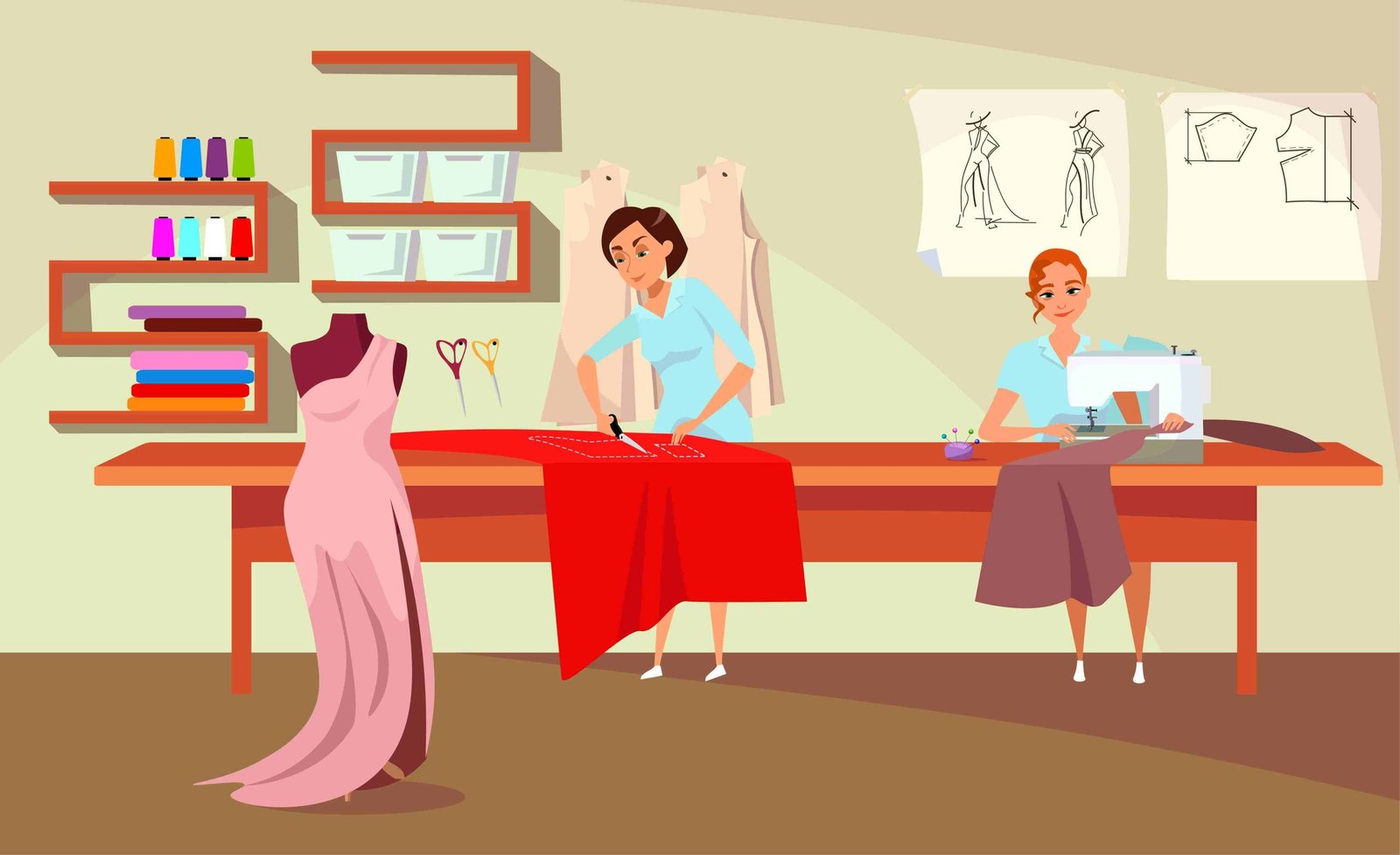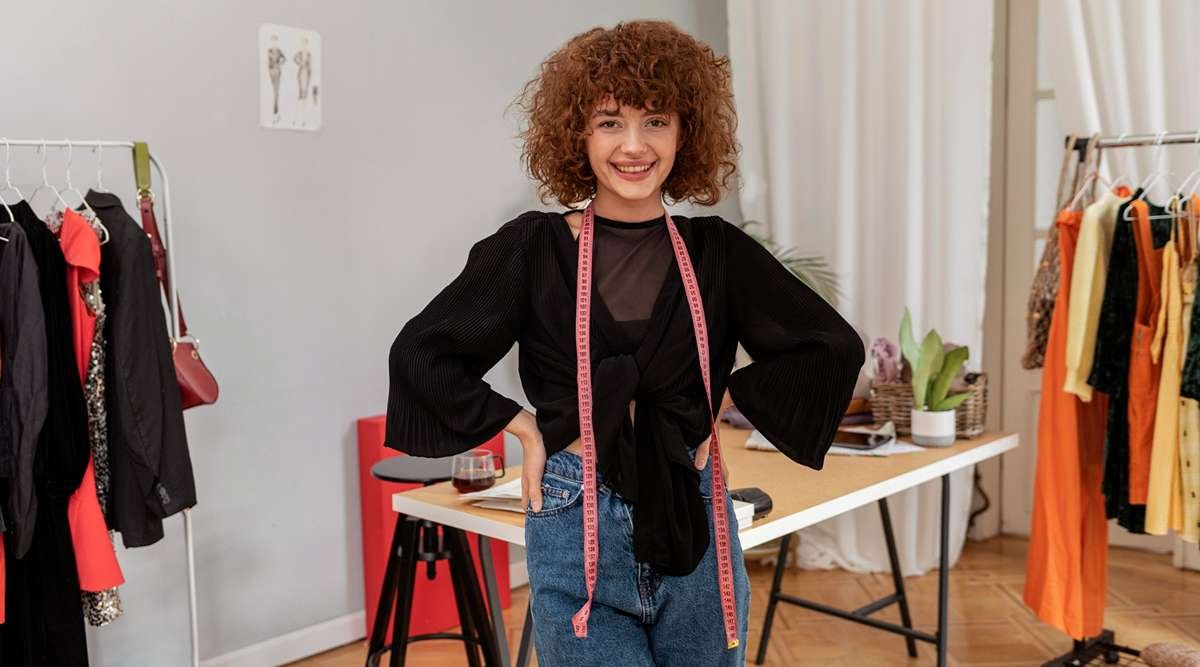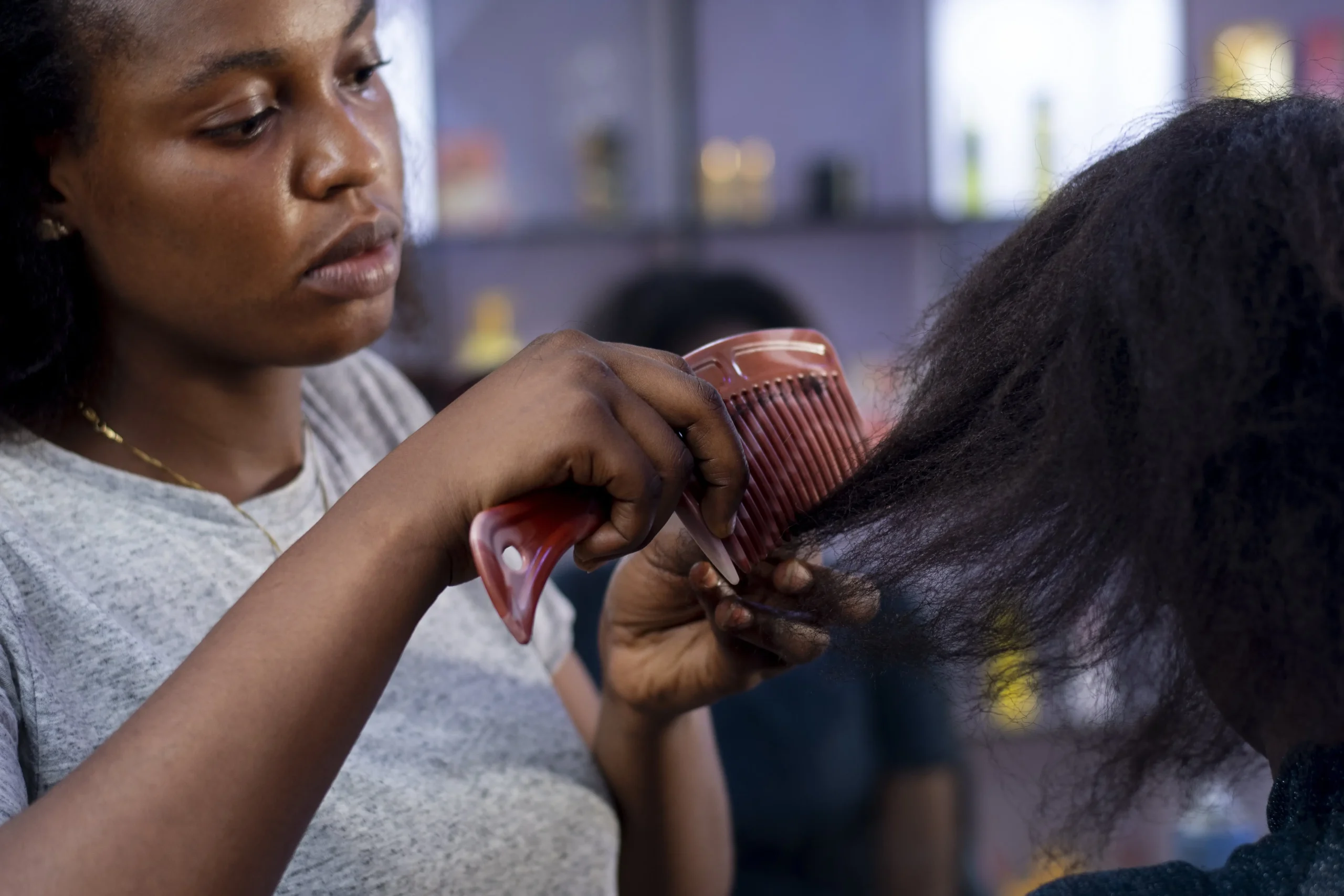
Here’s the quick and honest answer most dresses need about 2 to 3 yards of fabric, give or take. But hold on, it’s not the same for everyone. The amount can totally change depending on the kind of dress you’re making (like a maxi dress or something more fitted), your body size, and even how wide the fabric is. It’s not rocket science, I promise just a few simple things to keep in mind, and you’ll be good to go!
Why Fabric Yardage Isn’t One-Size-Fits-All
Let’s be real there’s no magic number that works for everyone. When it comes to fabric yardage, a few simple details can totally change how much you actually need.
How Body Size Changes Fabric Needs
Think about it like this: a dress for a petite person doesn’t need the same amount of fabric as one for someone taller or curvier. The more coverage your dress needs, the more fabric you’ll need pretty straightforward, right? And if you’re sewing something with sleeves or a fuller skirt, that’s even more yardage. So always factor in your own measurements, not just what a tutorial says.
How Fabric Width Affects Yardage (45″, 60″, etc.)
Now here’s a sneaky one people often miss fabric width. Some fabrics come in 45-inch widths, others in 60-inch. That extra 15 inches makes a big difference. If your fabric is wider, you’ll usually need less of it. But if it’s narrower, you might need to grab an extra yard or so to make everything fit. Always check the bolt label at the fabric store before buying.
Loose vs. Fitted Dresses (Mini, Midi, Maxi Dress)
Different styles, different needs. A snug little mini dress? Probably less than 2 yards. A maxi dress with lots of flow and flare? You could be looking at 4 or more yards, easy. Midi dresses fall somewhere in between. Basically, the looser or longer your dress is, the more fabric it’s gonna eat up.
Fabric Types That Change Everything
Let’s talk fabric—because not all fabric is created equal, and yep, it matters a lot when figuring out how many yards you’ll need. This part can really make or break your whole sewing project, so don’t skip it.
Stretchy vs Non-Stretchy Fabrics
If you’re working with stretchy fabric (like jersey knit), you can usually get away with using less. That stretch gives you wiggle room literally. It molds to your shape, so the design doesn’t need as much structure. But if you’re using non-stretchy stuff like cotton or linen, you’ll need a bit more fabric to make sure it fits comfortably and doesn’t pull weird when you move. So yeah, stretch saves yardage, but only if your pattern is designed for it.
Patterned Fabric vs Plain
Patterned fabric might look cute on the roll, but it’s tricky. You’ve gotta match the patterns stripes, florals, polka dots so everything lines up properly once it’s cut and sewn. That means you’ll need extra yardage for pattern matching. With plain fabric? No worries. You can cut it any which way and not stress over the design lining up. So if you’re on a tight budget, plain might be the smarter choice.
Lightweight vs Heavy Fabrics (Like Denim or Satin)
The weight of the fabric changes everything too. Light fabrics like chiffon or rayon are flowy and usually need more yardage for structure and layering. Heavier stuff like denim or satin? It’s bulkier, so you might need less because it holds shape better. But don’t forget they can be tougher to sew, especially for beginners.
How Dress Styles Impact Fabric Yards
Different dress styles = different fabric needs. A mini dress isn’t gonna eat up as much fabric as a long, flowy maxi, and if you’re going sleeveless? You might just save a few bucks at the fabric store.
Instead of dumping a wall of text here, let’s keep it super simple with this handy table:
| Dress Type | Fabric Needed (Average) | Notes |
| Mini Dress | 1.5 to 2 yards | Less fabric, tighter fit |
| Maxi Dress | 3 to 4 yards | Flowier style, needs more fabric |
| Flared/Midi Dress | 2.5 to 3.5 yards | Needs extra fabric for flare |
| Plus Size Dress | 3.5 to 5 yards | Add more for body coverage |
| Sleeveless Dress | Slightly less | Saves fabric by skipping sleeves |
Let’s be real—this isn’t an exact science. These numbers give you a general idea, but things can shift depending on your pattern, fabric width, or if your dress has extras like ruffles or pockets.
Pro tip: Always buy a little more than you think you’ll need. It’s way better to have leftovers than to run short halfway through your project.
Pattern Envelope & Matching Patterns
If you’re using a store-bought dress pattern, don’t just toss the envelope aside—it’s more than just a pretty cover. That little pattern envelope holds gold. Seriously.
What’s on a Pattern Envelope
Right on the back of that envelope, you’ll find the exact fabric yardage you need based on your size, the fabric width (like 45″ or 60″), and sometimes even extra notes if your dress has ruffles, pleats, or puffed sleeves. It’ll also list what kind of fabric works best for the pattern. So before buying anything, always check the envelope. It takes the guesswork out of yardage.
Why Pattern Matching Wastes or Uses More Fabric
Now, if you’re working with stripes, checks, florals, or any patterned fabric, this part’s huge. You can’t just cut pieces wherever you want. You’ve gotta line up the pattern so the design looks clean and not all over the place when it’s sewn. That means you’ll need extra fabric sometimes half a yard more, sometimes even a full yard depending on how bold or detailed the pattern is. It’s called pattern matching, and skipping it can make your dress look off.
Avoiding Mistakes When Cutting
A lot of fabric waste happens right at the cutting stage. Trust me, it’s super easy to mess up if you’re not paying attention to the grainline or how the pattern pieces are laid out. Use the cutting guide that comes with your pattern, and double-check how the prints line up before making that first snip. Oh, and always pre-wash your fabric first it can shrink!
Fabric Store Tips: Don’t Just Grab and Go
Walking into a fabric store can feel like stepping into a candy shop for the first time so many colors, textures, and options! But before you toss a few pretty bolts into your cart and run to the cutting counter, slow down. A little prep (and a few smart questions) can save you money, time, and headaches later.
How to Ask the Right Questions at a Fabric Store
Don’t be shy. The people who work there? They usually know their stuff. Ask things like:
- “Is this fabric good for dresses?”
- “What’s the fabric width?”
- “Does it shrink after washing?”
- “Can I return unused fabric if I bought too much?”
Most staff are happy to help, especially if you tell them it’s your first sewing project. They might even offer better alternatives you didn’t notice on your own.
Why Swatching Helps
If you’re not 100% sure about a fabric, ask for a swatch. Some stores give small samples for free or super cheap. You can take it home, feel how it drapes, test how it looks in natural light, or even wash it to see if it holds up. A quick swatch now can save you from buying 4 yards of something you end up hating later.
How to Tell Quality Fabric for a Dress
Here’s a simple test: grab the fabric, scrunch it up in your hand, then let go. If it wrinkles instantly and feels stiff or scratchy, it might not be the best pick for a dress. You want fabric that feels soft, moves nicely, and has a smooth finish, especially for something like a maxi dress or a fitted style. And don’t forget to check how see-through it is under the store lights. No surprises later, please.
How to Measure Yourself (Easily!)
Before you even think about buying fabric, you gotta get one thing right: your measurements. A lot of beginners skip this part or just kinda guess and that’s when dresses end up too tight, too loose, or just plain weird. Good news? Measuring yourself isn’t hard at all you just need a soft tape measure and a little patience.
Bust, Waist, Hips: What You Really Need
These three are your golden measurements:
- Bust: Measure around the fullest part of your chest, not too tight.
- Waist: This is your natural waist, the little dip above your belly button. Don’t suck in—breathe normally!
- Hips: Wrap the tape around the widest part of your hips and booty.
Write these down. You’ll need them for picking the right dress size and figuring out your fabric yardage.
Tape Measure Tips
Use a flexible, fabric tape don’t try this with a metal hardware one (seriously). Stand in front of a mirror to make sure the tape is level all the way around. And if someone can help you? Even better. Oh, and one little thing always measure over what you’ll be wearing under the dress (like a bra), especially if it’s fitted.
Common Measuring Mistakes Beginners Make
- Holding the tape too tight or too loose
- Measuring over bulky clothes
- Guessing instead of actually measuring (yep, guilty!)
- Forgetting to measure both hips if you’re not symmetrical (totally normal btw)
Getting your measurements right the first time makes sewing way easier and avoids wasting fabric. It’s one of those small steps that makes a big difference later.
Common Mistakes Beginners Make with Fabric Yardage
Let’s be honest, we all mess up a little in the beginning it’s part of the process. But knowing what to avoid can save you time, money, and a ton of fabric frustration. Here are some super common fabric yardage mistakes newbies make:
- Not buying enough
You get halfway through your dress, and uh oh you run out of fabric. Always buy a little extra just in case. - Buying way too much
The flip side: overspending on yards you’ll never use. Unless you’ve got another sewing project lined up, don’t go overboard. - Forgetting seam allowance and hem allowance
Those little extra inches on every edge? Yeah, they matter. Ignoring them means your finished dress could end up way too small or short. - Cutting fabric before double-checking pattern size
Big mistake. Always read the pattern carefully and double-check your measurements before cutting. Once you cut it—there’s no going back. - Assuming all fabrics behave the same
Stretchy, slippery, thick, or stiff—every fabric handles differently. Don’t assume they all need the same yardage or sewing tricks.
Avoiding these rookie moves makes a huge difference in how smooth your project goes—and how great your dress turns out.
Fabric Calculator Table
Wondering how much fabric you need for your next dress project? Use this quick-reference table to estimate yardage based on your size, dress style, and fabric width. It’s a handy guide whether you’re using a pattern or just winging it.
| Size | Dress Type | 45″ Fabric Width | 60″ Fabric Width |
| S | Mini Dress | 2 yards | 1.5 yards |
| M | Maxi Dress | 4 yards | 3.5 yards |
| L | Flared Dress | 4.5 yards | 4 yards |
| XL | Sleeved Dress | 5 yards | 4.5 yards |
What I Learned Making My First Dress
Okay, real talk when I made my first dress, I had no clue what I was doing. I picked out this super cute floral patterned fabric, didn’t check the pattern envelope, and just kinda guessed how many yards I needed. (Spoiler: I guessed wrong.)
I bought 2 yards thinking it’d be enough for a midi-style dress but turns out, with the flare and all, I needed more like 3. And I didn’t think about seam allowance or hem allowance, so it ended up being a little shorter than I wanted. Still wore it though just with leggings and a shrug to hide the “oops” areas .
But hey, I learned a lot. Now, I always double-check fabric width, go over the pattern layout, and buy a little extra just in case. It’s way better to have leftovers than to run back to the fabric store and pray they still have the same bolt.
FAQ’s
Is 2 yards of fabric enough to make a dress?
Sometimes yeah, especially if it’s a short or sleeveless style. But if you’re curvy or want a full skirt, 2 yards might leave you short. I always grab a little extra just in case been there, messed that up.
Can I make a dress with 3 yards of fabric?
Yep, 3 yards is usually plenty for most casual dresses. If you’re making something flowy or maxi-style though, you might need more. Better safe than sorry fabric’s cheaper than redoing the whole thing.
How to calculate fabric for a dress?
Check the sewing pattern first—it’ll tell you what you need based on size and fabric width. No pattern? Then look at similar dress tutorials or just add an extra half yard to be safe. Trust me, guessing rarely ends well.
How many yards for a formal dress?
Formal dresses usually take more fabric, especially with long skirts or lining. Think around 4 to 6 yards, maybe more if it’s poofy or has a train. Depends on your height and style, really.
What can I sew with 2 yards?
Loads of stuff—simple shift dresses, tops, skirts, even shorts. You’ve just gotta pick the right pattern. I once squeezed a wrap dress out of 2 yards, but it was a tight fit (literally).
How many yards are needed to sew a dress?
Usually 2 to 4 yards works for most dresses, but again—it totally depends on your design and body size. Always check the pattern if you’ve got one. Or play it safe and get a bit more.
How do I tell how much fabric I need?
Look at the back of the pattern envelope—it’s a lifesaver. No pattern? Google something close or swatch out a quick mock-up with scrap fabric. Don’t just eyeball it, unless you’re okay with making a crop top instead
Conclusion
So yeah, if you’re planning your next dress sewing project, just remember it’s not about guessing and hoping for the best. Think about the dress style, fabric width, and your measurements, and don’t skip checking that little pattern envelope. Usually, 2 to 3 yards of fabric is a solid starting point, but buying a little extra never hurts.
You’ll learn more with every dress you make, and soon you’ll be grabbing fabric like a pro. Until then, take your time, ask questions, and enjoy the process. Happy sewing, and may your fabric always be just the right amount!



